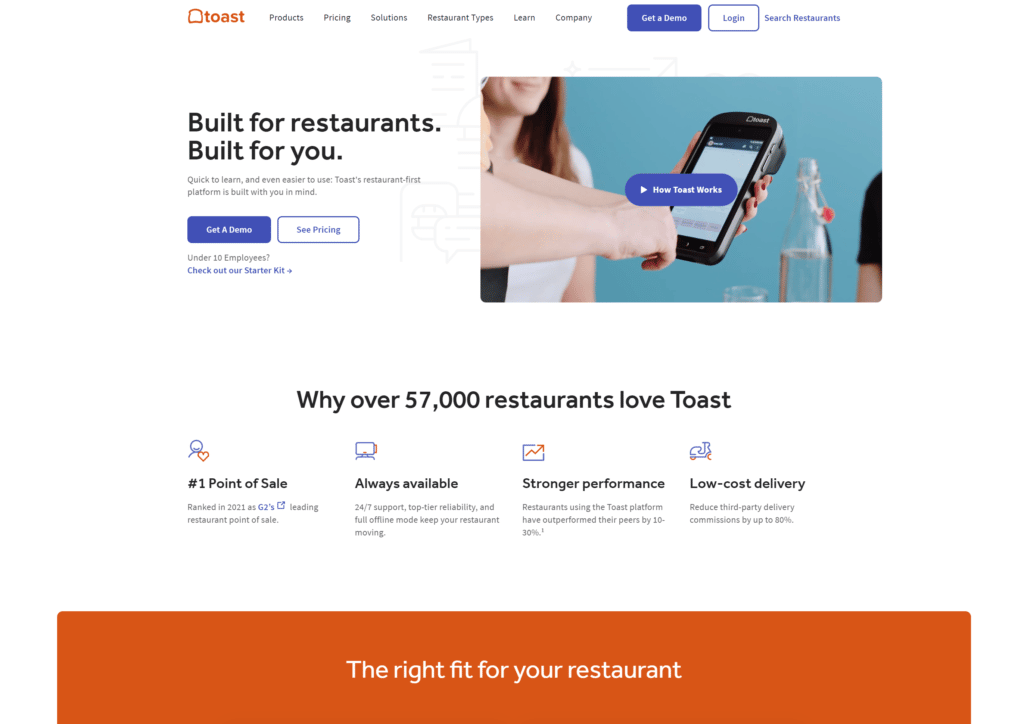Developing a comprehensive content marketing strategy and properly utilizing internal links was the key to growth
Increase in Organic Traffic
Links Earned
Monthly Traffic Value
Toast POS is a cloud-based restaurant management software company that is used in approximately 62,000 restaurants, from small cafes to nationwide enterprises, across the U.S.
Toast’s challenge was simple — build organic growth and add value through content, further stack on additional brand awareness, and get users into the Toast ecosystem to add value during their journey.
Toast had experienced a period of organic stagnation over the previous 6-8 months, so they needed a growth agency with the experience to help take them to the next level.
The business had two core goals for this project: first, to increase their content leads; second, to better optimize their existing content to achieve higher search engine rankings.
They took us on board for this project because we have a number of excellent case studies that show our fantastic past results-driving MQLs for B2B businesses. We have a proven framework for driving leads and promoting organic growth through content marketing.

To start, we conducted a content audit of the client’s pages, to see how well they were performing on a page level, and to quickly make decisions on which pages:
A content audit is an important first step that provides a visual map of the performance of all pages on a site. It also helps us to start building an attack plan for a campaign. It is a core starting point for understanding which pages are the low-hanging fruit items for generating big wins, quickly, especially for established B2B SaaS companies.
Next, on the more technical side, we looked at the linking structure between pages on the company site in order to understand how it was constructed. We did this to better optimize backlink performance and in order to push the most “link juice” to relevant pages. This is an important technique in so-called “SEO siloing”— siloing helps search engines identify what a website is about.
The idea is to build out clusters of relevant topics and build each topic into its own silo. We wanted to interlink these pages to drive relevancy for Google and to provide more link power to certain pages so that they ranked higher in search results.
Once we clearly understood all the existing content and how everything interlinked, we created a content workbook. The purpose of our content workbook is to track the process of content creation from the initial ideas stage all the way up to the publishing stage.
It allows us to carefully manage how all of our content links together and it helps us to double-check our work at each step long before anything goes live.
Next, we worked through each page, restructuring and re-optimizing existing content. Once we’d mapped out the best primary keyword for a page, we then created content around it.
For all our online content, we specifically outline how we will link one page to another with an anchor, and we very clearly spell this out for both the writers and the developers. Anyone who is going to be adding content to a page needs to understand where to insert contextual links.
We provided our content outlines to the in-house team, and once the drafts were ready, we reviewed the content against the outline to ensure we were hitting all of the high points and following the core internal linking structure.
I think the challenge, regardless of the client, is always to keep up the speed on the content creation side of things – creating a page-by-page analysis using keyword research can produce some of the best content strategies around, but you have to keep up the pace.
When we can’t publish content quickly enough, it drags out the time it takes to see real results.
Third-party providers can sometimes speed things up but typically subject matter experts come from in-house. It might be slower, but we typically prefer them.
“The workflow was seamless between our teams. Overall, their process was very close to ours, so it was a great fit from the get-go. Most importantly, we learned a ton from their approach.”
Dahlia Snaiderman – Senior Content Manager at Toast
—
Want results like these?
Partner up with RTR – a trusted B2B SaaS SEO Agency that drives real results.
Coming to the end of the campaign, we were able to reflect on some huge results.
A 200% increase in targetted organic traffic to bottom mid and top-funnel content assets – the core driver of organic traffic for the business.
In searches, 37 of our chosen keywords reached the #1 position. Many of these had previously ranked mostly at the bottom of the first page or on page two. We also acquired 41 high domain authority industry-specific links through our content marketing efforts.
We were able to stack on an additional $195k+ worth of monthly organic traffic value, which had a large impact on content leads:
In the end, Toast was already a pretty authoritative domain – but, we were able to beat higher authority domains simply by taking a structured and methodical approach to our content marketing strategy.
Book a 1-on-1 intro call with our founder that includes a FREE custom marketing plan. Start growing faster, today.
Book a 1-on-1 intro call with our founder that includes a FREE custom marketing plan. Start growing faster, today.